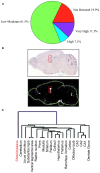Expression Profiling of Solute Carrier Gene Families at the Blood-CSF Barrier
- PMID: 22936914
- PMCID: PMC3426838
- DOI: 10.3389/fphar.2012.00154
Expression Profiling of Solute Carrier Gene Families at the Blood-CSF Barrier
Abstract
The choroid plexus (CP) is a highly vascularized tissue in the brain ventricles and acts as the blood-cerebrospinal fluid (CSF) barrier (BCSFB). A main function of the CP is to secrete CSF, which is accomplished by active transport of small ions and water from the blood side to the CSF side. The CP also supplies the brain with certain nutrients, hormones, and metal ions, while removing metabolites and xenobiotics from the CSF. Numerous membrane transporters are expressed in the CP in order to facilitate the solute exchange between the blood and the CSF. The solute carrier (SLC) superfamily represents a major class of transporters in the CP that constitutes the molecular mechanisms for CP function. Recently, we systematically and quantitatively examined Slc gene expression in 20 anatomically comprehensive brain areas in the adult mouse brain using high-quality in situ hybridization data generated by the Allen Brain Atlas. Here we focus our analysis on Slc gene expression at the BCSFB using previously obtained data. Of the 252 Slc genes present in the mouse brain, 202 Slc genes were found at detectable levels in the CP. Unsupervised hierarchical cluster analysis showed that the CP Slc gene expression pattern is substantially different from the other 19 analyzed brain regions. The majority of the Slc genes in the CP are expressed at low to moderate levels, whereas 28 Slc genes are present in the CP at the highest levels. These highly expressed Slc genes encode transporters involved in CSF secretion, energy production, and transport of nutrients, hormones, neurotransmitters, sulfate, and metal ions. In this review, the functional characteristics and potential importance of these Slc transporters in the CP are discussed, with particular emphasis on their localization and physiological functions at the BCSFB.
Keywords: Allen Brain Atlas; BCSFB; CSF; Slc gene; blood-cerebrospinal fluid barrier; choroid plexus; solute carriers; transporters.
Figures



References
-
- Alebouyeh M., Takeda M., Onozato M. L., Tojo A., Noshiro R., Hasannejad H., Inatomi J., Narikawa S., Huang X. L., Khamdang S., Anzai N., Endou H. (2003). Expression of human organic anion transporters in the choroid plexus and their interactions with neurotransmitter metabolites. J. Pharmacol. Sci. 93, 430–43610.1254/jphs.93.430 - DOI - PubMed
-
- Alper S. L., Stuart-Tilley A., Simmons C. F., Brown D., Drenckhahn D. (1994). The fodrin-ankyrin cytoskeleton of choroid plexus preferentially colocalizes with apical Na+K(+)-ATPase rather than with basolateral anion exchanger AE2. J. Clin. Invest. 93, 1430–143810.1172/JCI117120 - DOI - PMC - PubMed
Grants and funding
LinkOut - more resources
Full Text Sources
Miscellaneous

